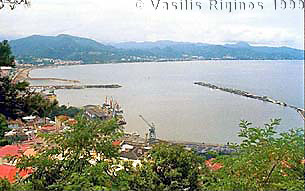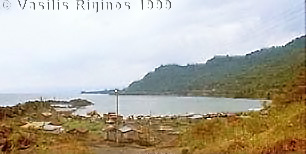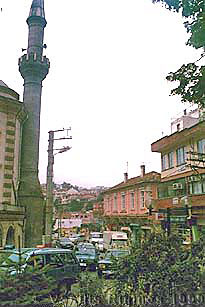This document contains the continuation of our trip east along the coast of the Black Sea, but we travelled by land from Samsun to Trabzon, visiting the region of Sumela in the vicinity of Trabzon, and then we returned to Samsun and S/Y Thetis by taking an inland route via Amasya. Other places that we visited are: Unye, Persembe, Ordu, Giresun, Tirebolu, the Sumela Monastery, the Vaselon Monastery, Sourmena, Tokat, and Turhal. The logs of the trip are illustrated with maps and photographs, and also include some historical and geographical descriptions of the places visited as well as several links to other related web sites.
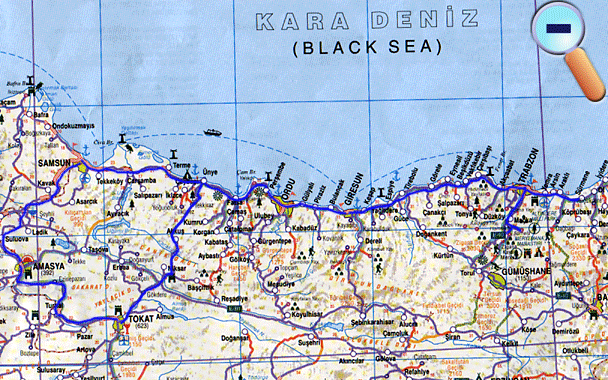
- Zoom-Out
- Samsun
- Unye
- Persembe
- Ordu
- Giresun
- Tirebolu
- Trabzon
- Sourmena
- Sumela Monastery
- Vaselon Monastery
- Tokat
- Turhal
- Amasya
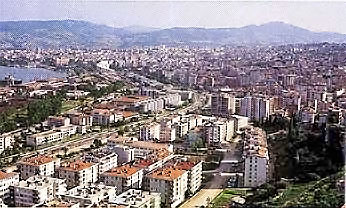
Samsun, the Greek Σαμψούντα, was founded by Ionian Greek colonists from Sinop in the 6th century BC, most likely attracted by the large harbor. They named the city Amisos. In the 5th century a second wave of colonists arrived, this time from distant Athens, led by Athenocles. The Athenians changed the name of the city from Amisos to Piraeus but, although the new name did not last for very long, the city flourished by trading with the interior of Anatolia. In the Hellenistic times Mithridates VI Eupator expanded the city and built many temples. During the Third Mithridatic War Amisos was burned to the ground by the Roman general Lucullus. Later Lucullus, regretting his action, rebuilt the city. Pharnaces, the son of Mithridates, recaptured the city from the Romans. He in turn was defeated by Julius Caesar and the city became a Roman possession again. It was after this victory that Caesar sent to the Senate in Rome the message: Veni, Vidi, Vici (I went, I saw, I conquered). After the Romans the city changed hands many times until 863 AD when it was taken from Omar, the emir of Melitene, by the Byzantines. In 1194 it was captured by the Selcuks. At various times it was held by the Comneni of Trapezous, the Mongols, and the Genoese. In 1425 the Ottomans captured it from the Genoese who, before abandoning the city, set it on fire. In the late 19th century the city, dominated by a large Greek population, became very prosperous by exporting tobacco directly to Europe. On May 19, 1919 Atatürk landed in Samsun and proclaimed the Kemalist movement that led to the creation of modern Turkey. Following the 1923 exchange of population treaty, after the Greek-Turkish War, all of the Greek population of Samsun along with all the other Greeks of the Turkish Black Sea were forced to migrate. Today, Samsun is a city of 300,000 inhabitants.
Sunday August 1, 1999, Day 20
Despite the smell, we slept well. There were surprisingly few mosquitoes. So, here we are having our coffee in the cockpit and taking stock of the situation. The good news is that we have actually arrived in Samsun, deep in the Black Sea. Another dream has been realized. Yet it is not what I had imagined! I expected a gracious city with old fashioned mansions reflecting past glories. Instead we are floating in the dirtiest harbor I have ever been in, worse than Jakarta where I went on business trip few years ago. But, I have to admit that the smell seems less strong than last night, I suppose that we are getting acclimated.
We looked around, there were at least 6 large ships, further W of us being loaded by enormous cranes. There was another landing about 50 m W of us where there were 2-3 small sailing dinghies on the concrete. Maybe that was the “Yacht Club.” Large fish, some as long as half a meter, were constantly jumping out of the water, which had the color of dark chocolate. We had some tasks to do on the boat, including refueling, and then we should locate a car to rent.
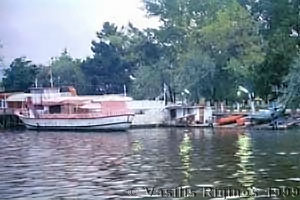
First, we attended to the engine. We changed the oil and the oil filter. Then we changed the two fuel filters. I used Mr. Bekatoros’ trick of sucking the line to re-fill the Racor filter rather then the messier use of bottles. It took us three attempts to bleed the fuel lines but finally the engine started and ran smoothly. No problem with the starting battery. Its voltage was good. After the engine, it was the watermaker’s turn. I changed its filter and filled it with the biocide solution. This was necessary since it will not be used for several days. We then armed ourselves with a long-handled swab brush and tried to clean the anchor, which still had a lot of disgusting mud and other stuff clinging on it. Next thing we knew, a row-boat with an old man came along also with a brush and he helped us clean the anchor and its chain. It was clear that Ergin had send him.
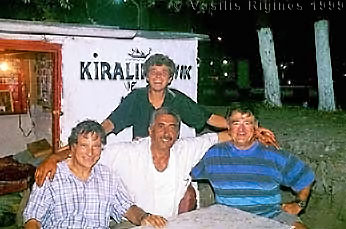
We went ashore and met Ergin. We have had long debates between Andonis and myself on what Ergin’s role really was. He appeared to be the leader of a sizable group of men, of ages ranging from 10 to 70, who jumped at his commands. All the fishing boats seemed to be under his jurisdiction. He issued his instructions to them with a VHF unit located inside his “office,” a small wooden shack. He had an uncanny resemblance to Anthony Quin in his role as Zorba the Greek. He is larger then life, the more we see of him the more he reminds us of Kazantzakis’ Zorba. He is Zorba the Turk! He says that he will call for fuel but there is some difficulty with deliveries because cars are restricted in the park that is enclosing this part of the harbor. At any rate, we understand that the delivery will be around 2:00 PM.
The Black Sea Cruising Guide has a sketch of the town which indicates that there is a Tourist Information Office. So, we walked that way thinking that it would be a good place to start our inquiries for a rental car. After some time, we found the office. The nice lady however, hardly knew any English, French, German, or Greek. But she did know, other then Turkish, Russian which we did not know. With great difficulty we communicated to her our needs. She produced a brochure of Samsun and wrote on it the address of a car agency. She also gave us vague instructions on how to find it in about “400 meters.” We walked in the direction she pointed to but after walking way over the “400 meters” we were convinced that we were lost. Andonis asked at a small hotel. The same language difficulty, but we did seem to be on the right track although the distance now had increased to “about 1 km.” On we went. It was very hot and humid. The city was vibrant with traffic and people but it was neither picturesque nor gracious. It was in fact an ugly dirty nondescript city with many stores, fishmongers, photo-copy stores, grocery stores, musical instrument stores etc. Lots of pedestrians. We kept asking every so often and kept on walking in the heat. Finally we saw a sign: “Cars to rent,” then another. Obviously we had arrived at the right district. Despite today being Sunday, all of these stores were open. Encouraged we went on. We saw a store with a very familiar Avis sign. We decided this may be a better bet and we entered.
It was very hot and stuffy inside and the man behind the counter spoke only Turkish, but he dialed his phone and handed me the receiver. At the end of the line was a lady who spoke good English. I explained that we needed a car, starting today, for 3 days. She asksed me to wait. Another voice, masculine this time, the English less competent. I repeated. “Just a moment,” then “please give me the local man.” I did so. After a long conversation I was handed back the phone. “Sorry but we do not have a car until August 5.” I thanked him and we were about to leave, when the local man called us back. We waited while he talked rapidly on the phone and then gave me the receiver once again. Same masculine voice: “you can have a car from tomorrow until Tuesday.” Sorry but we need a car from today till Wednesday. This time we did leave.
A block, up the street we saw another car agency with a large office: “Sakura Cars to Rent.” Andonis, whose wife is Japanese-American, could not resist this sign. We entered. A man, who could be either a customer or a friend, spoke reasonably good English and translated for us. It was Andonis’ turn this time. He explained our needs. Sorry, no car was available today but one will be available tomorrow morning. Also payment by credit card was not possible because their machine was not working. As we were leaving to try our luck elsewhere a gentleman with a mustache walked in. Everyone in the office, there were at least 4 men and a young woman, stood up and greeted him with great respect. He was the patrone. His name was Hassan Dere and he came from Georgia via Australia where he had lived for over 20 years. He spoke very good English. He immediately offered us çay (tea). After a long and roundabout conversation, covering the state of the world, our cruising, education in the US, conditions in Georgia, Turkey, Greece, and Australia, we worked out a deal. He will deliver us a car today, some time between 4 and 6, which we can keep till Wednesday and we will pay him $150 in dollars and in cash. He will deliver the car to the boat in the harbor. All of these negotiations had taken a fair amount of time. We shook hands and left.
We walked back to the harbor through the hot streets. It seemed that the harbor, at least our part of it, was enclosed by fair grounds where there was entertainment in the evening and a large Russian market during the day. The grounds were packed with people. We walked to Ergin’s office, where we found him surrounded by his entourage playing backgammon. He explained to us that he had arranged for a fuel delivery but the truck can enter the grounds only between 6 and 8 AM. But we were not to worry. He will get us 100 liters and store it in two large drums until we come back from our land trip. He will also lock our outboard in a safe place and will keep the inflatable zodiac away from curious hands. He then engaged us in the usual conversation of international politics and the relations between Greece and Turkey in particular. So far on this trip everyone we have encountered has been very friendly and helpful despite us being Greek. Now, for the first time, we encountered a hostile person among Ergin’s minions who delivered a long and angry tirade which we did not understand but it was punctuated with “Younanis” (Greeks) and “Yunanistan” (Greece) followed by unfriendly stares in our direction. No one in the crowd seemed to agree with him. After he had his say, Ergin transfixed him with his eyes and told him something very softly. The angry young man, just got up and left. We never saw him again. Now, Ergin smiled at me, pated my shoulder and said; “Vasile, Antone, Ergin, arkadas” (friends).
After parting from Ergin and his court, we walked to what we now thought could be the “Yacht Club.” Indeed it was but there were no yachts, just a few sailing dinghies engaged in a local race, manned by boys under ten. A very distinguished and official looking gentleman wearing a blue blazer and holding a pair of binoculars seemed to be presiding. He introduced us to a young Russian man who was the trainer. The trainer, who spoke very good English, definitely knew about the foreign yacht that had arrived last night. We asked him if we should bring her near the “Yacht Club.” He said: “No, you are under the protection of Ergin Bey. You cannot do any better in Samsun. If Ergin Bey is looking after your yacht, no one will bother her or you. She is moored at a very secure mooring.” While we had a cool beer under the shade of the restaurant, they told us that they were very excited awaiting the arrival of the Kayra Rally (Karadeniz Yacht Rally) which started from Istanbul and is circumnavigating the Black Sea. The rally was organized by the Ataköy Marina in Istanbul.
By this time I was getting hungry, so I wanted to get back onboard Thetis and have some lunch. Andonis, on the other hand had already eaten some snacks from a street vendor and wanted to do some more exploration. So, we parted and I took the zodiac back to Thetis. I had just finished making a salad and was about to eat it along with some fruits when I saw a head appearing over our stern. It was our Georgian friend Hassan and his partner who had been ferried to Thetis by one of Ergin’s underlings. Hassan beamed at me and declared that our car was ready and waiting for us. The time was 3:30 PM! Of course, what they really wanted was to come aboard. They did. He introduced his partner, a fellow Georgian who has lived in Japan and whose wife was Japanese, hence the name “Sakura Cars to Rent.” More small talk while we were waiting for Andonis. I offered them some coffee. They were very curious about our way of life afloat. Eventually Andonis showed up. I went to get him. More socializing. At last we all went ashore to look at the car.
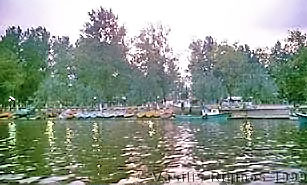
Hassan insisted on talking to Ergin to make sure that our understanding with him was what we thought it was. Yes Ergin had everything under control. He will get us the fuel, look after Thetis, etc. He even offered to have someone sleep aboard in the cockpit. We assured him that it would not be necessary. We sensed an undercurrent that Ergin was resenting Hassan’s interference. We walked outside the fair ground to a parking lot. The car was an old beat up Fiat of Turkish manufacture but it seemed to work and its tires were not too worn. It would do. Andonis handed Hassan the money, he gave us the keys, and we all shook hands. Hassan invited us, after our return, out to dinner.
We went back aboard Thetis and packed some bags for the trip. When we got all our stuff to the landing with the zodiac, everyone rushed to help us. In a flash the outboard was removed and disappeared. The zodiac was towed away to be tied on a moored fishing caïque away from land. Once again I tried to ascertain the fuel arrangements. Ergin got impatient with me: “Haide, Vasile, Haide.” (Go on your way Vasili, go on your way) and he herded us off. Our land adventure was about to begin.
The car was almost empty, so our first order of business was to fill it up. By some unspoken agreement, Andonis was the driver and I the passenger. We filled it for about 17 million TL ($25). We drove out of Samsun heading East towards Trabzon. The road quickly changed from a two-lane highway to a one-lane roughly paved road heavy with truck traffic. The area was incredibly ugly and industrial. We had reached Unye when it began to rain. Soon it became a downpour. We almost got stuck in a stream of water at a low point of the road. Andonis was having some trouble finding the switch that turns on the lights. We could not see very well and had to stop. I got out of the car to watch the effects of various switches as Andonis flipped them. I got quenched but we got the lights. We took care of this none too soon because it got dark very quickly.
Unye, the Greek Oinaion (Οίναιον), was the stronghold of Andronikos I Comnenos, the grandfather of Alexios and David, the founders of the Trapezous or Eastern Byzantine Empire. Andronikos, after the death of his cousin Emmanuel I Comnenos the Byzantine emperor, went back to Constantinople, murdered his nephew Alexios, married his teenage wife, Agnes the Frank, and became the emperor.
As we were driving in the dark, and in the heavy rain we became aware that we were driving along a very scenic road. Too bad that we could not see very much. There were many trucks moving very slowly on the narrow winding road. I looked at the guidebook and, after some discussion, we decided to stop at the Vona Hotel just before Persembe. It was past 9:00 PM when we found the hotel. The rooms at about $40 each were clean and adequate. The meal at the hotel restaurant by the pool was rather indifferent. Lots of mosquitoes.
Monday August 2, 1999, Day 21
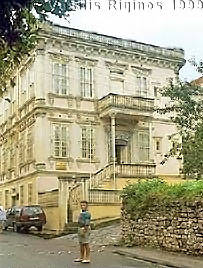
After we checked out of the hotel we drove to the nearby town of Ordu the Greek Kotiora (Κοτύωρα), also founded by Ionian colonists from Sinope. As this was a sizable town it seemed to be a good place for Andonis to change some travelers’ checks and for me to mail a check to Alice in Washington. The first task proved to be rather daunting. Very close to where we parked the car we found the “Tourist Information” Office. Inside, the polite young man who spoke very good English directed us to the Kambyo (Exchange) Office, he also gave us information on what to see in the town. At the Kambyo Office they did not take travelers’ checks and they directed us to a bank across the street. At the bank, after waiting for our turn, they directed us to a central bank, the Zizaat Bank. The inside of the Zizaat was a total chaos completely mobbed with people. It was also hot and humid and very unpleasant. We waited in line, and when our turn came, the man behind the counter looked at Andonis’ $100 American Express travelers’ check and called his superior, a large lady. Both spoke reasonable English and were very polite. They offered us çay (tea). It is hard to describe how surrealistic it felt to be going from pillar to post for the exchange of a miserable $100 check and then in the middle of a chaotic mob scene to be offered tea! She produced a large album of sample travelers’ checks and she started leafing through trying to find a match with Andonis’ check. Alas, his was of a very recent edition and did not match. She asked Andonis if he had any $50 checks. To her great relief he produced 2 of them. These matched. She and the first clerk, quickly finished the inevitable paperwork and took them to the cashier. She blatantly put our papers at the top of the cashier’s pile thus advancing us ahead of at least 20 other people. At last, one hour and ten minutes after entering the bank, we triumphantly emerged with the money. The post office was easy. After the post office, following the suggestion of the young man at the Tourist office, we visited the restored Makrides Mansion (Pasaoglu), now a museum. This was a very elegant building that shows a gracious life that ended in 1923 when the Pontic Greeks were forced to leave according to a treaty between Greece and Turkey after the tragic Greek-Turkish War war which ended a Greek presence along the S coast of the Black Sea that went back for over two millennia.
From Ordu we drove to Giresun the Greek Kerasus (Κερασούς). After Pharnaces I, king of Pontos, captured the town in 183 BC he renamed it Pharnaceia. In 71 BC Kerasus was taken by the Roman general Lucullus and again in 64 BC by Pompey. Legend has it that Lucullus imported to Rome the cherry tree from Kerasus. In the Byzantine era the town changed hands many times between the Selçuks and the Byzantines. From 1204 to 1461 AD Kerasus belonged to the Empire of Trapezous. It was then taken by the Ottomans. On May 20, the feast of a Moslem holy man, Hidirellez, is celebrated in Giresun. On that day, pilgrims flock on the little island Giresun Adasi and form a circle around a large black rock and insert pebbles into the rock’s cervices while making wishes. Local lore has it that this ceremony dates back to the Argonauts and that Giresun Adasi is the island of Ares sacred to the Amazons.
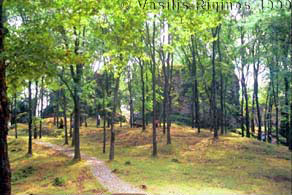
Near the Castle |
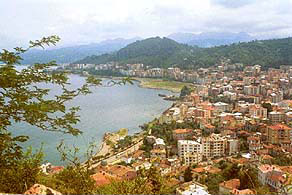
|
Every town we drove by along the way, including Giresun, was full of ugly apartment building blocks, most of them unfinished, but already deteriorating. The streets were littered with uncollected trash. This situation was particularly offensive in Giresun, which is located amidst a very beautiful natural setting. The observation that wherever man trods he destroys nature is particularly apt for this region. As we had been in the car for a while we parked it and started walking up to the Giresun Castle (Kale). While the view was great, the way was very arduous because by then it was excruciatingly hot and humid. We should had driven. By the time we reached the castle we were completely drenched with sweat. We were also hungry. After looking around the castle we started our descent. We wanted to locate the famous (according to our guide) Mehmet Efendi restaurant on the waterfront. Alas, it has been closed down. We were directed to an adjacent restaurant up some stairs on the second floor. It was hot and the TV was blaring. We were not comfortable, and we got up and left. We drove the car up to the castle and had a delightful lunch of peynirli (something like an oblong pizza) in a little restaurant under the shade of a large tree. The view was perfect and the peynirli was excellent. This was one of the few times that I had a great urge for an icy cold beer but unfortunately the proprietors were very religious (all the ladies wore full length costume) and served nothing alcoholic. Andonis had an ayran (a drink based in yogurt) which he declared as excellent.
After this peaceful and much-needed lunch, we continued our drive to Trabzon. The scenery on the way was fantastic, lush deep green vegetation everywhere interrupted by pockets of urban jungle in the shape of ugly dirty buildings. We went past Tirebolu the Greek Tripolis (Τρίπολις), with a 14th century Genoese castle, and the pretty harbor of Görele.
When we arrived in Trabzon the Greek Trapezous (Τραπεζούς) it was rush hour. The traffic was very heavy and it was extremely hot and humid. Positively unpleasant. We passed by one of the hotels recommended in Andonis’ tourist guide but since the “Tourist Information” office was not too far away we stopped there first. In the office there was a very nice and helpful elderly lady whose English was impeccable. After giving us various options she directed us to the newest and most expensive hotel in town, the Zorlu Grand Hotel. What made us choose it was that it was air-conditioned. We got there and checked in, it cost $126/night. The rooms were nice, large, cooler and more importantly dryer then the outside.
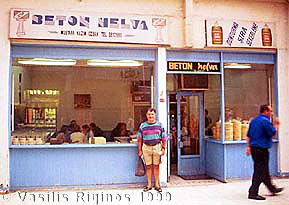
After cooling down in our rooms, we went for a walk. The hotel is in the Maydan (Market) district. In our walk we inspected all the restaurants recommended either by the lady at the tourist office or by our guide books. We decided to go eat at the highly recommended Kirbis (Cyprus) restaurant. During the walk a shoe-store struck Andonis’ fancy, and on an impulse he bought a pair of shoes. Not far from the shoe store we stumbled into a remarkable store. It was entirely devoted to halvah (helva in Turkish). It had numerous varieties. Halvah is a sweet made with sesame and honey. Andonis, who is definitely addicted to halvah, was in the seventh heaven. Needless to say we bought a respectable amount. Very pleased with our exploration, we went back to the hotel for showers and a change of clothes. I got down to the hotel lobby and while waiting for Andonis ordered a raki. After a while the young man came and served me a pot of hot tea. He must have misunderstood me, but no problem he took it back and brought the raki. Andonis soon joined me.
Following our earlier decision, we went to the Kirbis and walked up the two fights of stairs. My first impression was rather negative because of a blaring TV set, but after we sat down they started bringing us, without any ordering, appetizers (mezedes) one after the other. They were terrific. These were followed by grilled palamut (Black Sea bonito), a plate of ripe fruits, and a very tempting plate of delicious Turkish pastries.
The rooms at the hotel, despite the air-conditioning, were hot during the night.
Tuesday August 3, 1999, Day 22
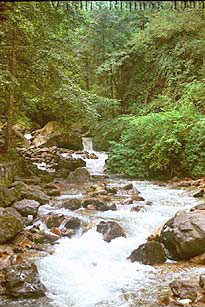
We left the hotel around 8:00 AM heading S towards the mountains to visit the Sumela Monastery in the Pontic Alps (Ποντικές Άλπεις or Kara Deniz Daglari) the high mountains with peaks reaching altitudes of 3,937 m (12,917 ft). Sumela is considered the most important Orthodox monastery after the ones on Mt. Athos and Mt. Sinai. Trabzon, although it is a bustling and fascinating town, it is architecturally dreary like most towns we have seen so far in the region of the Black Sea. It has large concrete apartment buildings, in dreadful shape, gray, and run down, that make Athens look like an architectural wonder.
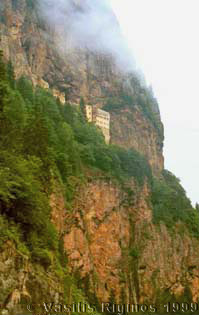
After leaving the town the view improved, lush hills, deep green colors with scattered houses (still of the concrete box variety) perched on the slopes. The scenery reminded me of Hawaii, the same steep green slopes, with deep canyons carved by water falls. Soon in a deep gorge we reached the end of the paved road that leads to Sumela. The gorge was lined with cedar trees, streams and running water was everywhere. The tall peaks above were covered with clouds. While the rough road does go further up, we decide to walk, following the narrow path, rather than to drive up the treacherous, steep, muddy road. The path was also very steep but the scenery was breathtaking. We crossed the road where workers were loading carved stones onto a makeshift cable car that carried them up to the monastery close to the clouds. While it was still early in the day and we were shaded by both clouds and tall trees, we sweated profusely. The monastery could be glimpsed perched on the sheer rocks, clouds rolling by across the peaks and deep valleys. In many ways, the monastery looks like a much larger version of the monastery in Amorgos. We went on. At last we were there.
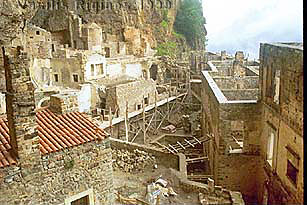
What a shock! What we were seeing from afar is only a shell of the outer wall. All of the monastery is actually a terrible ruin. The magnificent Byzantine frescoes are totally exposed to the elements, not even a canvas canopy to protect them. Most of them are brutally vandalized, many eyes have been gouged. Crude graffiti, both in Greek and Turkish, mars most of their surfaces. The view of the mountain peaks, hidden by clouds, was both dramatic and breathtaking. Every surface was wet by the dew. Water was everywhere. While very humid, the air was cool. A spring within the monastery drenched our thirst with sweet tasting ice cold water.
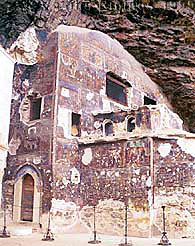
The Chapel |
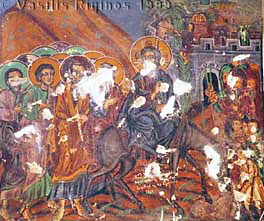
Fresco |
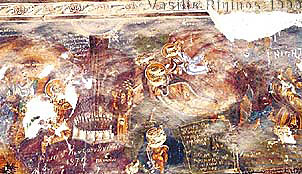
Graffiti on the Freco |
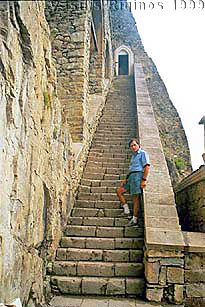
The Entrance |
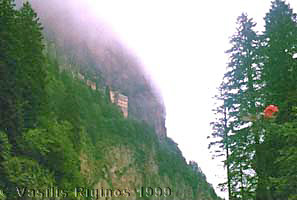
Stones ferried to the Monastery |
|
Reconstruction work was on going. They were bringing large stones, one at a time, with the cable car. The stones, which looked totally foreign from the existing old masonry stones, were used to rebuild walls. It was not clear if they actually followed the original plan. This crude wall reconstruction was going on while the precious and irreplaceable frescoes remained unprotected. It was madness! While we were elated to have been able to see this Byzantine marvel we were also depressed by its condition, active destruction in the not-too-distant past, present lack of protection, and misguided reconstruction.
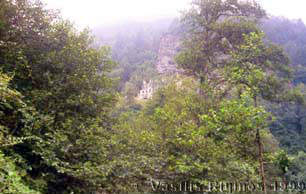
Since we were here, we decided to visit also the near-by Monastery of Vaselon. According to the guide it was just a 15 km drive. After some difficulty, we found a faded sign for the monastery. The distance written on the sign was hard to read, it could have been 3.73, or 7 km. Following the sign we got onto a rough dirt road that goes up, and up. After somewhat more than 3 km we arrived at an alabalik (trout) restaurant, which was standing in the middle of nowhere among the steep green mountains. We drove some more. The road was deteriorating, becoming rougher and muddier, and after we crossed a rickety wooden bridge we got so scared that we parked and walked for about 30 minutes along the road. At the end of the road we took a steep and very slippery path that led us to the monastery. It was a pitiful sight! A total wreck. The little chapel, with some remaining magnificent but defaced frescoes, was used to store hay for the livestock. Manure was everywhere. A sizable local family had preceded us, the children having climbed up the treacherous walls into the monastery, and were now giving us advice how we too could get in. We followed them, more ruins, more manure, more defaced frescoes. Very, very sad. The family was very friendly and took our picture. Back we went, rather subdued, to the car and drove towards Trabzon.
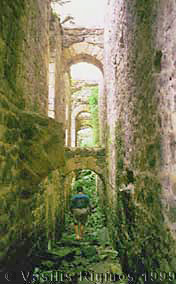
|
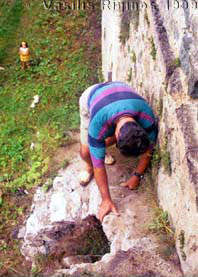
Andonis Climbs the Ruins |
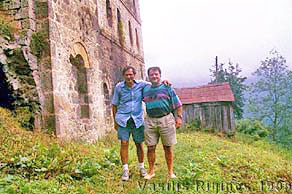
Vasilis & Andonis |
|
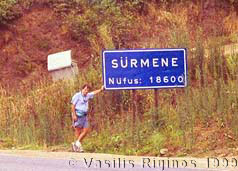
Now, both of us wanted to go as far east as possible and even better to get to Georgia. Andonis, whose father came form Georgia was particularly keen on doing so. Because of time constraints (we needed visas) and information we had from Hassan about bandits, and because we could not drive the rented car across the border, it was obvious that we would not be able to go to Georgia. Nevertheless, instead of returning directly to Trabzon, we turned east and drove as far as Sourmena. The Greek refugees from Sourmena, back in 1923, established a settlement which they also named Sourmena in Glyfada, the suburb of Athens near which I grew up. So, reaching the “real” Sourmena had a symbolic meaning for me. We photographed each other under the road sign.
Back in Trabzon we took a walk, seeking the Catholic Church that was supposed to be near our hotel. We got lost but two lovely little girls showed us the way. They were somewhat shy, but also very keen to practice their English. The air of the city was very heavily polluted by exhaust fumes and who knows what else.
Trabzon the Greek Trapezous (Τραπεζούς) was founded by settlers from the Milesian colony of Sinope, modern Sinop, towards the end of the 7C BC. They were followed by emigrants from Trapezous in Arcadia, who gave the foundation its name. In addition to seeking new land for cultivation, it seems likely that the settlers were also engaged in trading in metals with northern Anatolia and the Caucasus. Some authorities maintain that it was through Trapezous and Sinope that Urartian bronzes reached the Greek world, so helping to produce the so-called Orientalizing period (c 720-550 BC) in Greek art. In the summer of 400 BC, a few days after their unnerving encounter experience with deli bal, crazy honey, Xenophon and his Ten Thousand reached Trapezous. They stayed for about 30 days, camping in the Colchian villages. According to Xenophon (Anabasis IV, 8) they spent most of their time ravaging the countryside, an action unlikely to have endear them to their hosts. Relations with the colonists of Trapezous were better. They gave the mercenaries presents of oxen, barley and wine. Because of its geographical location Trapezous was better-suited than either Sinope or Amisos to be the terminus of the long trade route from Persia and eastern Anatolia to the Black Sea. Although occupied by Mithridates and later by a Roman army under Lucullus, the city came through the Mithridatic Wars (88-63 BC) largely unscathed. Hadrian (117-138 AD) visited Trapezous in 129 and adorned it with many buildings and ordered the construction of a large harbor. The city continued to prosper under his successors. Captured and sacked by the Goths in c 260 AD, it was rebuilt during the reign of Diocletian. Justinian (527-565 AD) had its fortifications extended and improved. In the 11th century Trapezous successfully repulsed the attacks of the Selçuks. The early 14 century author of The Travels of Sir John Mandeville describes it as a “good city” where St. Athanasius, bishop of Alexandria, who wrote the psalm Quicunque vult, was buried “upon the gate of the city”. It was governed by Guido “of the lineage of the emperors of Constantinople,” but subject to the rule of the Tartars.
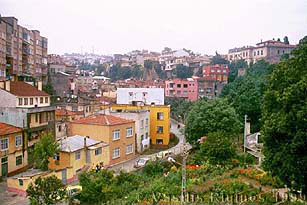
Shortly before the capture of Constantinople by the Crusaders in 1204 the Grand Comneni Alexios and David, grandsons of that unhappy emperor, Andronicos I, who was torn to pieces by an enraged mob in Constantinople in 1185, founded the Empire of Trebizond. Reared to manhood by their Georgian royal cousins, they captured the city in April 1204. Then, marching westward along the coast they took Sinope, and brought Paphlagonia and the Heraclea Pontica under their control. The 19 emperors and three empresses of their royal house ruled over a long narrow strip of land, 7000 square miles in area, which stretched along the eastern shoreline of the Black Sea. They lived in surroundings of unparalleled splendor. Cardinal Bessarion, who was born in Trebizond and who lived through the last days of this Byzantine outpost, has left a detailed account of the wonders of the royal palace. He describes the myriad ante-chambers and wind-towers, the magnificent state apartments, whose walls blazed with brilliant frescoes and mosaics, and the great balcony with a pyramid-shaped roof where the emperor gave audience to ambassadors and issued instructions to the officials of his court. However, in time the strength of the dynasty was sapped by internal rivalries, which produced plots and counter-plots. Emperors perished, an ex-empress was strangled, an usurper poisoned. Trebizond acquired an unmatched reputation for decadence and intrigue. It was rumored that every form of vice was practiced by members of the imperial court.
The judgment of historians on the Grand Comneni has been harsh, but it is unlikely that the rulers of Trebizond were more cruel or more debauched than their Georgian, Byzantine, or Ottoman counterparts. According to Pereira:
Their main interest seems to have been the pursuit of beauty, and their tastes were catholic: a church or a palace, a dancing-girl or a page-boy, all found favour in their eyes provided they were beautiful; they loved music and literature; and they wore splendid clothes.
The end of the empire came very swiftly. Mehmet the Conqueror, who had taken Constantinople in 1453, assembled a great army in Bursa in 1461 and marched E across Anatolia. Stopping briefly to invade Sinop, which was surrendered to him without a struggle by the Muslim rulers who had seized it from the Comneni, he reached Trebizond in the incredibly short time of 18 days. At the same time his fleet of 200 ships anchored off the coast. Although some historians suggest that the city was treacherously handed over to the enemy by the Imperial Treasurer, George Amiroutzes, it seems likely that David, the last emperor of Trebizond, recognized that defeat was inevitable. He was treated generously by his conqueror. He and his family, including his handsome, sexually ambivalent nephew Alexios, were given a safe conduct to lands in the Struma Valley in the Balkans and a pension of 300,000 pieces of silver. His subjects were not so fortunate. One third were sold into slavery, one third sent to Istanbul, the rest were allowed to stay in Trebizond. David did not live long after the destruction of his empire. A letter from his niece, who was married to Uzun Hasan, the White Sheep Emir, was intercepted and shown to the Sultan by Amiroutzes. This contained an innocent request to her uncle to send one of his sons to Uzun Hasan’s court. Although David was almost certainly not guilty of any intrigue, Mehmet decided to take no risks. The ex-emperor and all his sons, except a child aged three, were brought to Istanbul. There they were beheaded.
Trabzon had important links with the Ottoman court. Before he became sultan, Beyazit II was governor of the city. His son and successor, Selim I, held the same position. Selim’s son, Suleyman the Magnificent, was born in Trabzon. Under Ottoman rule the city continued to be a major center of commerce. Until the construction of the railway line between Ankara and Erzurum, in the 19th century, caravans of camels, traveling over the perilous mountain trade route, continued to bring their precious loads of silks and spices from Persia and beyond.
The Russians occupied the city from 1916 to 1918. The sizable and prosperous Greek population of the city, encouraged by the Russians, declared the independent republic of Pontos. After the Russians left, Turkey retaliated by deporting first the Armenians and then the Greeks.
The historical information on Trapezous as well as on other Black Sea locations comes from Turkey, Blue Guide and from Mariana Koromila's Πόντος - Ανατολία: Φωτογραφικό οδοιπορικό; Pontos - Anatolia, Fotographico odiporiko (in Greek).
Back at the hotel we took a steam bath (hamam). It was very relaxing. We were too tired to seek new restaurants so we went to the one in the hotel. The meal was disappointing and rather expensive. The air-conditioning in our rooms had improved significantly after we had complained.
Wednesday August 4, 1999, Day 23

We tried to leave early so as to be back at Samsun not too late. But the dining room did not open for breakfast until 7:00 although the receptionist last night told us that it opens at 5:00. We were in no way going to drive in the morning rush hour without being fortified with coffee. We did not get going until 7:45. We started driving back west towards Unye. We passed an incredible sight: A haystack with a TV satellite dish!
On the way we stopped at a PTT (post office) to mail the postcards that we had written. The man behind the counter actually placed the stamps in each one of our 18 postcards and under no circumstances was he going to let us go until they were all postmarked and placed in his “out” box. He then stood up and shook our hand while wishing us “Güle, güle” (Go gently, go gently). This is Turkey for you! A simple operation like cashing a travelers’ check can take hours and a great run-around but also a bank will serve you tea and the post office man will shake your hands and wish you a good journey.
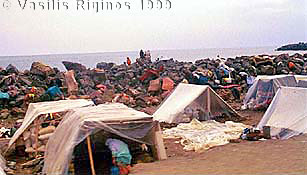
On the way we saw a Gypsy camp along the shore. What amazed us were the primitive and colorful tents among the heavy concentrations of refuse.
At Giresun we stopped to see the City Museum that is housed in an 18th century Greek church. The exhibits were nothing special or very interesting save for some old photographs that give one a glimpse of what life at the old Pontos (Black Sea) used to be 100 years ago. Turning a church into a museum, is I suppose, better than vandalizing it or letting it disintegrate, yet I am not too comfortable with the idea.
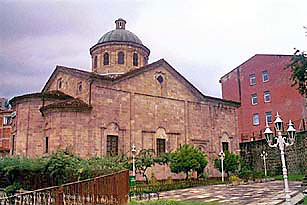
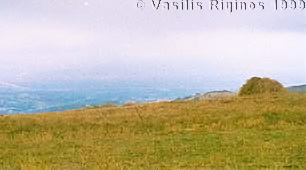
At Unye, after we did some provision shopping, instead of continuing west along the coast we turned inland to the south, wishing to visit Amasya. The road climbed up the mountains, with many hairpin turns, towards Tokat. Half way up, we were totally immersed in the clouds and we could hardly see the road. As if this were not enough, it started to rain. Soon we were driving inside a thunderstorm. The temperature plummeted. When we reached the ridge of the mountain, the downpour stopped as suddenly as it had started. We were now above the clouds and we could see again. The scenery had changed from the lush green forest to an alpine grassland. The grass was interspersed by ugly brick factory buildings clustered around villages with equally ugly houses. Before we reached the town of Turhal, we crossed a section of the road that was lined with local peasants selling mushrooms. We were not able to resist the temptation and bought some. After Turhal, the road descended from the mountains down to a valley along the Yesilirmak (the Greek Iris - Ίρις) river. The scenery now was completely different, it was arid and more Mediterranean. We followed along the river until we reached Amasya.
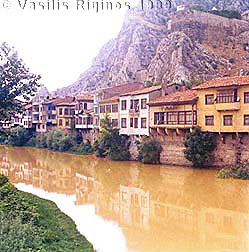
The first settlement in Amasya (Αμάσεια) was established on the summit of a precipitous peak which here dominates a narrow part of the river valley. It probably antedates the arrival of Alexander the Great in Asia Minor. There are about a dozen Hellenistic tombs on the cliffs of the river valley. After the death of Antigonos, Mithridates proclaimed himself king of Pontos, made Amaseia his capital, and founded a dynasty which lasted for almost 300 years. During the Third Mithridatic War Pompey captured the city and razed it to the ground. Later rebuilt under the Romans, Amaseia was a provincial capital. Strabo, the Geographer, was born c 64 BC into a distinguished local family which at first supported the Pontic king Mithridates Vl in his struggle against Rome, but which later changed sides and adopted the Roman cause. Strabo studied at Nysa and later in Rome where he lived for a number of years. He traveled from the Black Sea to Ethiopia and from Armenia to Etruria. In 24 AD he visited Egypt with his friend Aelius Gallus, the governor of that country. It seems likely that he spent some time studying mathematics and astronomy in Alexandria. Strabo wrote his Historical Memoranda, a 47-book work of which only fragments survive. His Geographica in 17 books, which draws heavily on the work of earlier Greek geographers, was designed for the use of members of the government and higher civil servants. In addition to the detailed practical information, it is peppered with anecdotes and legends and describes the antiquities and customs of the lands which it covers. Strabo, whose name rather unflatteringly means “squint-eyed,” died c 21 AD.
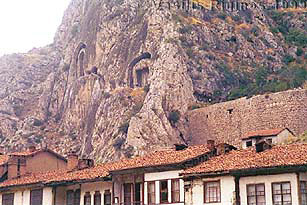
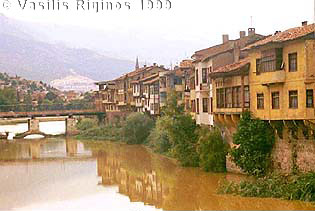
After the arrival of Christianity Amaseia became an Episcopal see. Bishop Eulalios of Amaseia attended the Council of Nicaea in 325. The fortress, enlarged and strengthened by the Byzantines, fell to the Arabs in 712, but was recaptured by the Byzantines during the reign of Leo the Isaurian (717-41). The last Bagratid king of Armenia, Gagik II (1042-45), received a grant of lands from the Byzantine emperor Constantine IX in eastern Cappadocia and made Amaseia his capital. After the battle of Manzikert in 1071 the Turks took Amaseia and renamed it Amasya. The Danishmendid clan established a powerful emirate here. In 1133 John II Comnenos failed to capture the citadel and had to be content with pillaging the lands of the Danishmendid. Later Amasya came under the rule of Kiliç Arslan and his successors. Taken by the Mongols in the 13C, it became part of the possessions of the Eretnids and of Kadi Burhaneddin, the emir of Sivas. In 1392 it was taken by Beyazit I for the Ottomans. During the centuries that followed Amasya was greatly favored by several Ottoman sultans who chose to live here. They made it a center of culture and learning that was frequently compared with Baghdad. Later the town fell into a decline which was compounded by earthquake damage in the 18C, 19C and 20C and a disastrous fire in 1915. It has never quite recovered from these catastrophes and today seems to have accepted the role of quiet provincial capital.
The historical information on Trapezous as well as on other Black Sea locations comes from Turkey, Blue Guide.
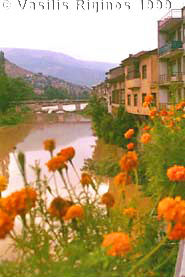
The present town is built along a river whose water has a yellow color. It has some lovely old houses along the banks of the river. It is surrounded by mountains with large carved tombs. Unfortunately, surrounding the charming old center of the town are the inevitable concrete apartment blocks that are so prevalent along the Turkish Black Sea. Despite these ugly buildings, the town is very attractive, in fact, it is the most attractive town we have seen so far in the Black Sea. As we were, by this time, rather hungry, we had a nice lunch at the terrace of the Sehir Klübü (City Club) overlooking the river. The waiter while opening the half-bottle of wine that we had ordered, managed to push the cork inside the bottle. Unperturbed he assured us that there was no problem since the wine could flow out into our glasses. While eating the GSM phone chirped, it was Manos calling us from Athens to find out how we were doing. I sensed a certain envy in his voice. After walking around the pleasant banks of the river, and buying some more provisions in a local super market, we got back to the car for the long drive to Samsun.
We drove the 120 km to Samsun. By the time we arrived it was almost 8:00 PM. The drive was dreary as the road was full of lorries emitting clouds of noxious exhaust fumes. We managed to find a parking spot outside the fair ground and, with some apprehension as to what we would find, we carried our luggage to Ergin’s headquarters.
He was there, playing backgammon with his followers, about 5 of them. His “office” consisted of a plywood shack. Inside, there were a VHF, a radio, a cot, and a table. The walls were covered with photographs mostly of the man himself with friends, relatives, visitors, and with his numerous staff. Also, there were two posters from an old calendar, with semi-naked Japanese pin-up girls. To my great relief, inside the “office” along with a collection of engine parts, old electric motors, and other debris was also our Yamaha outboard and two 50 L drums full of Diesel fuel. In front of the shack was a small concrete landing where Ergin held court. We could not see our zodiac anywhere but Thetis looked exactly the way we had left her. We waited but there was no movement towards fetching the zodiac. Without the zodiac, of course, we could not get back aboard Thetis. We watched the game. Ergin had greeted us and continued to roll his dice, totally unflappable. I sensed that this was some sort of test. We watched the game. Then another one. Then I was offered to play with him. I lost of course. It was Andonis turn. I looked at the Diesel drums, “Iraq mazut” (Iraq oil) exclaimed Ergin with a smile. He continued to roll the dice. At last, with a twinkle in his eye, he pointed out to the water with his head. A motor boat was approaching. It was towing behind it our zodiac. Inside the zodiac was a young man whom we had not seen before. He produced the oars, which were disassembled, and tried to put them back together but had trouble doing so. Somebody else waded in the filthy water and pulled the zodiac to the landing. The painter was covered with muck. I jumped in and started assembling the oars while some other member of the staff brought the outboard, which I installed. During all this time Ergin just sat and watched without uttering a word, a faint smile was creasing his face from time to time. As we loaded the zodiac I explained to him that we would be back with our kücük (small) cans to which we would siphon the oil to take it back to Thetis.
Thetis was a little dusty but other than an incredible amount of weed grown on her underside did not look any worse for the her stay in Samsun. We stowed our belongings and siphoned fuel from the two remaining jerry cans into the tank. We then took all the empty cans, plenty of paper towels, as well as our siphon ashore. In the meantime, they had brought the two drums outside the shack and had lifted one of them on top of the backgammon table. Our siphon, sifon, (consisting of two plastic hoses and a plastic hand pump), met with general approval. We quickly filled the two 25 L jerry cans, the only trouble was keeping the all-too-eager hands away and avoiding spillage. We then started filling the 20 L cans. When the level in the drum was getting low the siphon was not too effective, but a bearded old man with very lively and sparkling deep blue eyes cut a plastic soda bottle thus producing a hone (Greek χωνί - honi). With someone holding the hone over the can and another one tipping the drum, we emptied both drums in no time and with minimum spillage. While I was wiping the siphon and jerry cans with paper towels, the old man casually tossed the hone into the water. We loaded the cans into the zodiac and ferried them to Thetis.
I called Hassan, our Georgian friend, with the GSM phone and told him we were back and that he could have the car. He said he would be over right away. We had hardly finished stowing the cans when we were called from ashore. After some consultation, I left Andonis to finish the stowing and I went ashore with the zodiac. It was not Hassan but someone he had sent. I gave him the car keys saying that we were in the midst of a difficult operation. There was no mention of the dinner invitation from Hassan that he had issued a few days ago.
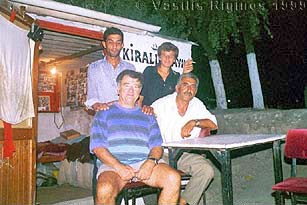
Back ashore Andonis asked Ergin about the cost of the fuel. He said that he had paid 26 million TL for the 100 L, which was about what we had calculated by observing prices at gas stations. So, Ergin was not only true to his word and had made our trip to Trabzon possible but he was also very honest. Andonis paid him and also gave him an extra 10 million which Ergin refused to accept. Only after Andonis insisted that it was for his “staff” he accepted it. I had brought ashore the camera and flash and took several pictures of Ergin and his people who were so helpful to us. Ergin insisted that we drink to our friendship and produced a large bottle of vodka. He filled three water glasses up to the brim. We all drank. He refilled them. We asked what we should bring him from the US, should we be back again in Samsun. After some reflection, he said what he really wanted was a new VHF radio. These are frightfully expensive in Turkey and if we would be kind enough to bring him one he would reimburse us.
Slowly we staggered, as we were definitely under the influence of the vodka, to a nearby modest restaurant within the fair grounds and had a snack. Then we got back at the landing and we took our leave from the unforgettable Ergin, who assured us that we would have fair winds and wished us a good journey. Back aboard Thetis all was very quiet, save for the splashes of the fish. We set the alarm clock for 5:00 AM and went to sleep.
